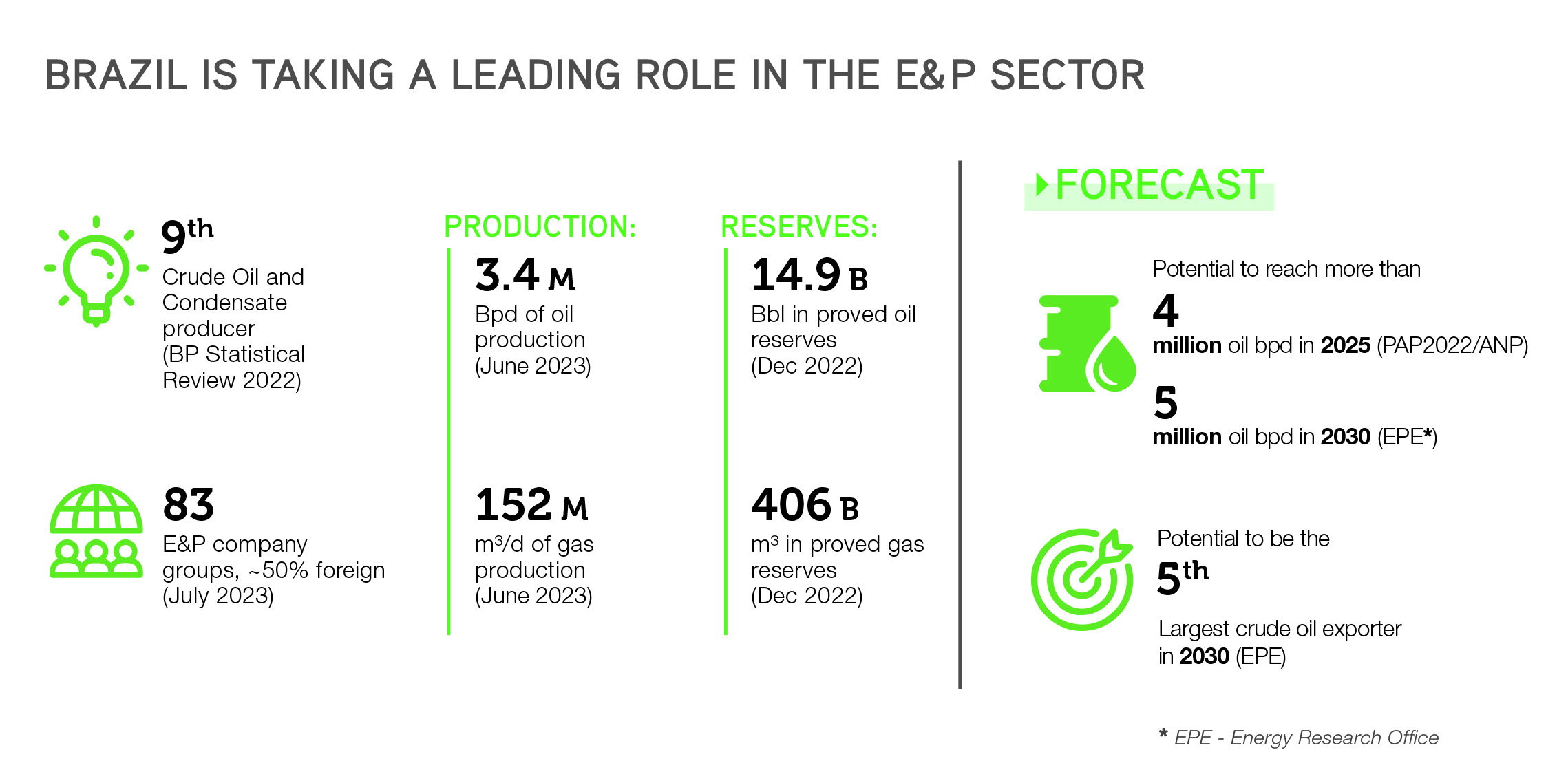Investment Opportunities in Brazil
- The regimes of concession and production sharing
The discovery of the pre-salt polygon, in 2007, made the government establish, in 2010, the regime of production sharing. Until then, all the areas were granted under the concession regime. Ever since, Brazil has a mixed regulatory regime.
How the concession regime works
In the concession regime, the concessionary company assumes the risk of investing and finding – or not – oil or natural gas. The company will have the property of the oil and gas discovery in the conceded area. Through this model of contract, the company pays the government takes, such as the signature bonus, payment for the occupation or retention of the area (in the case of onshore blocks), royalties and, in the case of fields the produces large volumes, a special participation. The contracts are signed by the ANP on behalf of the Federal Union. In these bidding rounds, the interested companies offer, individually or in a consortium, an amount for the bonus signature and propose a minimum exploratory program (PEM), that is, the activities, such as the seismic and well drilling that the company commits itself to carry out in that area. The company or consortium that presents the most advantageous bid, according to the norms established in the tender protocol, receives the right to explore that area to verify the existence of oil and/or natural gas deposits.
How the production sharing agreement works
For the areas located in the pre-salt polygon and other considered strategic, the CNPE decides if bidding rounds will be held or if Petrobras will be directly hired, in order to preserve the national interest and achieve other energy policy objectives. In both cases, contracts are signed under the regime of production sharing.
If it decides to conduct the bidding round, CNPE first offers Petrobras the preference to be the operator of the blocks to be contracted. When Petrobras expresses the interest of acting as the operator, it must inform in which areas it wants to exercise this right, indicating its participation in the consortium, which cannot be less than 30%.
The blocks and the technical and economic parameters of the production sharing agreement are defined by CNPE and the bidding round promoted by the ANP. The Ministry of Mines and Energy (MME) is responsible for establishing the guidelines to be observed by the ANP for the promotion of the bidding round and for the drafting of bidding documents and contracts, later approved by the ministry.
In the bidding rounds under the regime of production sharing, the winning company is the one that offers the Brazilian State the largest share of oil and natural gas (that is, the largest portion of the exceeding oil).
The consortia that explore the pre-salt are composed by the Pré-sal Petróleo S.A. (PPSA) , representing the Federal Union, and the winning companies of the bid. The contracts are signed by the MME, on behalf of the Federal Union.
- How to contract areas for exploration and production in Brazil
There are two ways of contracting areas for exploration and production of oil and natural gas in Brazil: through bidding or farm-in. In the first case, the contracting can take place through a traditional bidding round or the Open Acreage.
The Open Acreage is currently the main model for the bidding of areas for exploration and production of oil and gas in Brazil, both in onshore and offshore areas, including the pre-salt.
More dynamic than the traditional ones, the auction is initiated when a company expresses interest in a certain area from a pre-defined portfolio. The process becomes even more attractive since companies, including foreign ones, can indicate areas to be tendered, subject to analysis and approval by ANP.
In traditional bidding rounds, both in the concession and sharing model, the Government publishes a public notice with the rules, criteria for choosing the winners, areas on offer, etc. Interested companies then have pre-determined time to study the areas and the offers are made in a public bidding session. Currently, there is no forecast of new bidding rounds in this model.
Another way of acquiring areas for exploration and production in Brazil is the farm-in, which consists of transferring the rights of an exploratory block or field from one company to another. This transfer must be authorized by the ANP and the new company must sign the contract for the area with the Agency.
- Open Acreage
Since the publication of CNPE Resolution nº 27/2021 in December 2021, the Open Acreage system has become the preferred system for the tender of new areas for exploration and production of oil, natural gas, and other fluid hydrocarbons. This system is divided into two modalities: Open Acreage under Production Sharing (OAP) for areas located in the Pre-salt Polygon, and Open Acreage under Concession (OAC) for other areas.
Nomination of areas by economic agents
ANP Resolution nº 837/2021 plays a crucial role in this context as it governs the nomination of areas by economic agents. This resolution serves as a mechanism for the market to identify and propose new areas of interest that could potentially be included in the Open Acreage. It also provides the flexibility to modify the design of already available blocks to accommodate possible prospects or leads or even entire clusters of structures, thereby enhancing the attractiveness of those areas.
Public Sessions for Presentation of Bids on December 13th, 2023
4th Cycle of the Open Acreage - Concession
2nd Cycle of the Open Acreage - Production SharingOutcome of the Open Acreage O&G Bidding Rounds:
• Concession: 3 cycles, 121 contracts, BRL 886 million (≈ USD 196 million) in minimum investment and BRL 501 million (≈ USD 107 million) in signature bonus;
• Production Sharing: 1 cycle; BRL 1,44 billion (≈ USD 273 million) in minimum investment and BRL 916 million (≈ USD 173 million ) in signature bonus.
Opportunities in the Open Acreage
Currently, there are 955 blocks available (plus Japiim gas marginal field) in the OAC modality, and six areas available in the OAP modality (plus Ametista, to be added soon). Additionally, there is a stock of 1,006 blocks under study (plus 15 marginal accumulation oil fields) for future inclusion in the OAC.
The blocks in the OAC modality are distributed across various Brazilian sedimentary basins, as illustrated in the map below.
Concession
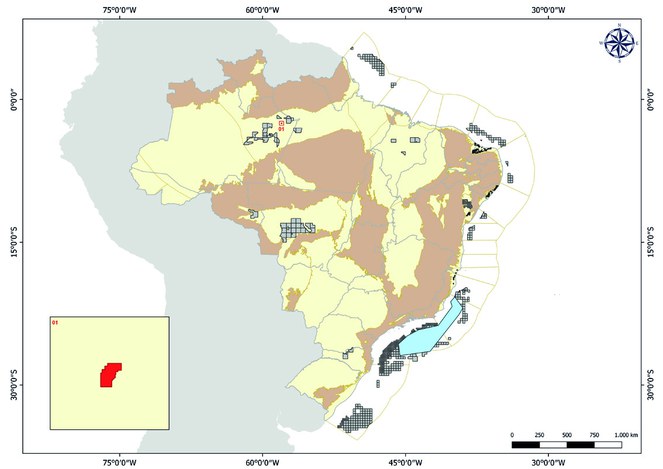
The areas in the OAP modality are distributed as illustrated in the map below.
Production Sharing (Pre-salt & Strategic Areas)
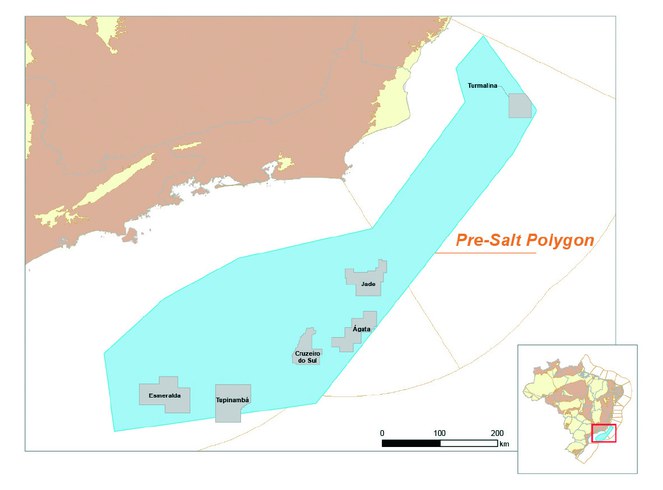
- Onshore Potiguar, Sergipe-Alagoas (SEAL), Espírito Santo, Mucuri and Recôncavo basins
-
These basins are classified as mature by ANP, indicating that they are in an advanced stage of exploration and possess well-developed infrastructure and a skilled local workforce. The blocks within these basins all have a minimum signature bonus of R$ 50,000. These opportunities primarily benefit small and medium-sized companies, enabling the continued exploration and production of oil and natural gas in regions where these activities hold significant socioeconomic importance.
Over the past years, Petrobras has divested several assets in these four mature basins, including production and development fields, clusters with complete infrastructure, and exploratory blocks.
TThere are currently 307 blocks available through the Open Acreage system within the mature Brazilian basins and an additional stock of 220 blocks for future inclusion on the Open Acreage as summarized in the table below.
Basin
Blocks Available
Blocks in stock
Onshore Potiguar
176
42
Onshore SEAL
78
87
Onshore Espírito Santo and
Onshore Mucuri
26
37
Recôncavo
27
54
- Onshore Potiguar Basin
The Potiguar basin has undergone significant transformations due to Petrobras' divestment program. The transfer of these assets to companies of appropriate size has yielded positive results, as exemplified by the "Polo Riacho da Forquilha." Between 2011 and 2019, the production of this area declined by 48%. However, under the new operator from 2020 to 2021, the downward trend was reversed, resulting in a 7.2% increase in production.
There are 176 blocks available in the Open Acreage in this basin. Also, there is an additional stock of 42 blocks for future inclusion in the Open Acreage.
Furthermore, internal studies conducted by ANP have identified areas with geological conditions like those of current producing fields in the blocks currently available.
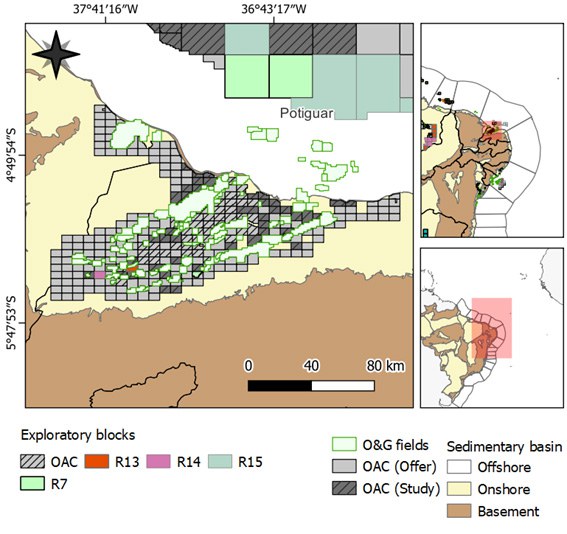
- Onshore Sergipe-Alagoas (SEAL) Basin
The onshore Sergipe-Alagoas basin is comprised of two subbasins: the Sergipe subbasin and the Alagoas subbasin.
Currently, there are 78 onshore blocks available in the Alagoas subbasin, with an additional stock of 87 onshore blocks for future inclusion in the Open Acreage, mostly located in the onshore Sergipe subbasin.
Over the past decade, the onshore Sergipe-Alagoas basin has experienced the highest production decline, reaching approximately -72% between 2011 and 2021. However, internal studies conducted by ANP have identified exploratory opportunities across various stratigraphic intervals within this basin, encompassing a range of structural and mixed traps.
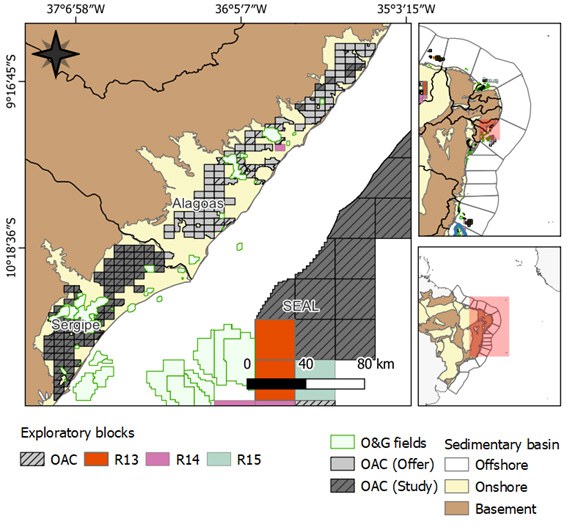
- Recôncavo Basin
The Recôncavo Basin is an aborted rift and the only mature Brazilian basin without an offshore extension. The basin has an historical importance in Brazil since it is the location of the first commercial oil well in Brazil and the birthplace of the Brazilian oil industry.
Like other mature basins in Brazil, the Recôncavo Basin has experienced a decline in production over the past decade. However, it is showing signs of recovery, mainly attributed to the Petrobras divestment plan. Approximately 70% of the O&G fields are now operated by several independent companies, which have implemented plans to increase the recovery factor. This effort has already resulted in a reversal of the production decline in the basin.
There are 27 blocks available in the Open Acreage in this basin. Also, there is an additional stock of 54 blocks for future inclusion in the Open Acreage.
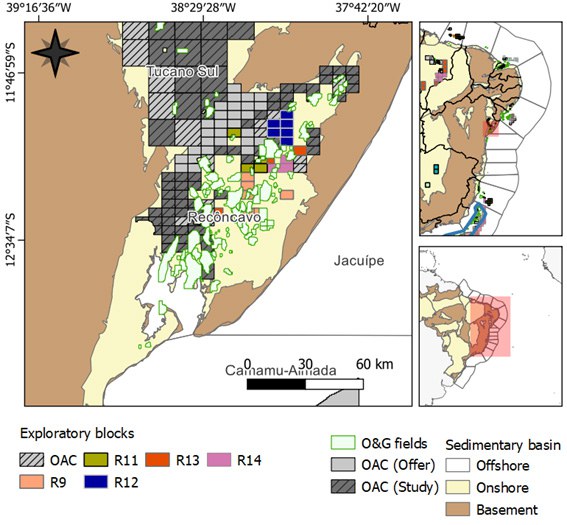
- Onshore Espírito Santo and Mucuri Basins
The improvement in the production trend of the onshore Espírito Santo Basin, along with other mature basins, underscores the significance of ANP's initiatives, such as reducing and fixing the signature bonus in these areas and providing free access to exploratory data, including seismic and well information.
These measures aim to ensure proper access to these resources in capable hands. It is worth mentioning that the discussions surrounding the implementation of the Open Acreage System in Brazil were initially prompted by these mature basins, with the objective of expanding opportunities and fostering diverse participation from various stakeholders, given the strong local socioeconomic component.
More than 60% of the O&G fields in onshore Espírito Santo basin are now operated by independent companies. Mucuri basin has only one O&G field operated by Petrobras.
There are a total of 26 blocks available in the Open Acreage in the Espírito Santo and Mucuri basins. Also, there is an additional total stock of 37 blocks for future inclusion in the Open Acreage on these basins.
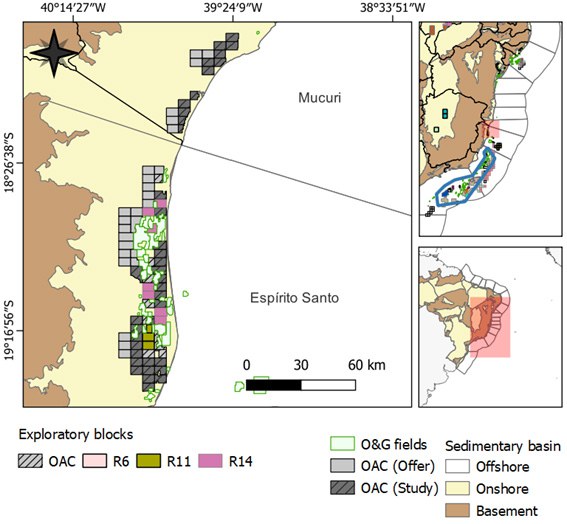
-
- Onshore Frontier Basins
-
The Amazonas, Parnaíba, and Paraná basins are vast Paleozoic basins that share similarities in terms of hydrocarbon generation, mainly associated with atypical petroleum systems with the presence of diabase sills in contact with the source rock, particularly from the Devonian period. These sills also serve as traps, seals and even reservoirs. All these basins hold potential for natural gas discoveries and, potentially, condensate and light oil.
While the Parnaíba basin was previously considered to have limited potential, it now accounts for nearly 5% of the country's total gas production. The Amazonas basin has recently entered its production phase with the Azulão field, which produces non-associated natural gas in an innovative model, supplying the Jaguatirica II Thermoelectric Plant in Roraima.
In the Paraná basin, the Barra Bonita field resumed its natural gas production in 2022 in after it was bought by Barra Bonita Óleo e Gás. Also, regional seismic surveys contracted by ANP have revealed structures like those observed in the Gaviões Cluster of the Parnaíba basin.
The Parecis Basin, recently dated to the Proterozoic era and reinterpreted, has undergone regional seismic surveys contracted by ANP. These surveys indicate the presence of significant structures capable of storing substantial volumes of natural gas within the offered blocks. Recent wells have confirmed the presence of potential reservoir rocks in at least three intervals, with indications of mature source rocks.
The Tucano Sul and Tucano Central basins belong to the same rift system as their neighboring Recôncavo basin. Presently, there are five active gas fields and three marginal accumulations in the Tucano Sul Basin.
There are currently 87 blocks available through the Open Acreage system within the onshore frontier basins and an additional stock of 101 blocks for future inclusion on the Open Acreage as summarized in the table below.
Basin
Blocks Available
Blocks in stock
Amazonas
21
6
Parnaíba
4
48
Paraná
2
32
Parecis
21
0
Tucano Sul and Tucano Central
39
15
- Amazonas Basin
Despite the discovery of two natural gas fields over two decades ago, the Amazon Basin had never experienced hydrocarbon production. However, this recently changed with the commencement of production in 2021 at the Azulão field, originally discovered in 1999.
The gas extracted from the Azulão field is utilized for power generation at the Jaguatirica II thermoelectric plant, which has a capacity of 117 MW. This plant was contracted in the first auction for isolated power systems held in 2019. The gas is liquefied and transported via trucks to Boa Vista, the capital of Roraima.
There are 21 blocks available in the Open Acreage in this basin. Also, there is an additional stock of 6 blocks for future inclusion in the Open Acreage.
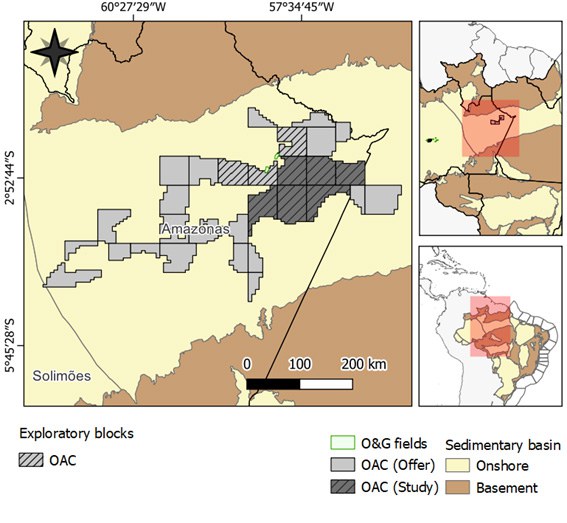
- Parnaíba Basin
The Parnaíba Basin, located in northeastern Brazil and spanning an area of approximately 600,000 km², is a gas prone basin. It currently has six natural gas fields in production and another four under development, all within the Gaviões Cluster.
The basin's hydrocarbon accumulation model is characterized by the presence of diabase sills, which serve as catalysts for hydrocarbon generation and as seals for the primary accumulations. Despite the Parnaíba Basin experiencing decades of stagnant exploration activities, there has been a resurgence of interest in the past decade due to the ANP's concession of exploration blocks.
The investments made by the regulatory agency and concessionaires have elevated the Parnaíba Basin to the status of a natural gas producer, making it the second-largest onshore gas producer in Brazil.
There are 4 blocks available in the Open Acreage in this basin. Also, there is an additional stock of 48 blocks for future inclusion in the Open Acreage.
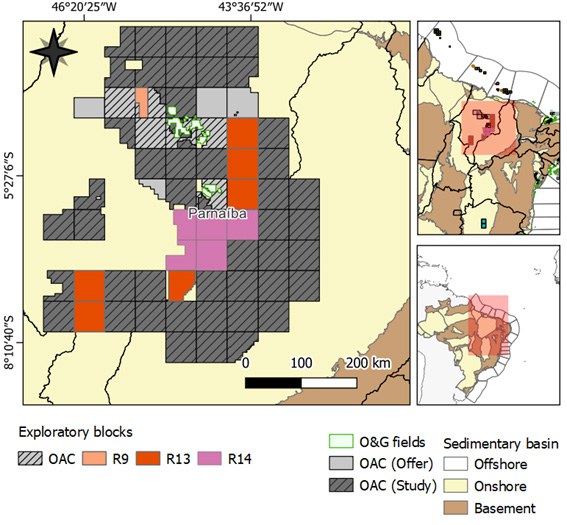
- Paraná Basin
Paraná Basin is in the most industrialized region of South America. It holds promising potential for natural gas accumulations, with one field already in production. The basin encompasses two petroleum systems, evidenced by oil and gas shows encountered in various drilled wells and the Barra Bonita natural gas field.
The expected exploration play in the Paraná Basin is like the Gaviões Cluster in the Parnaíba Basin, with diabase sills playing a crucial role in controlling natural gas accumulations.
There are 2 blocks available in the Open Acreage in this basin. Also, there is an additional stock of 32 blocks for future inclusion in the Open Acreage.
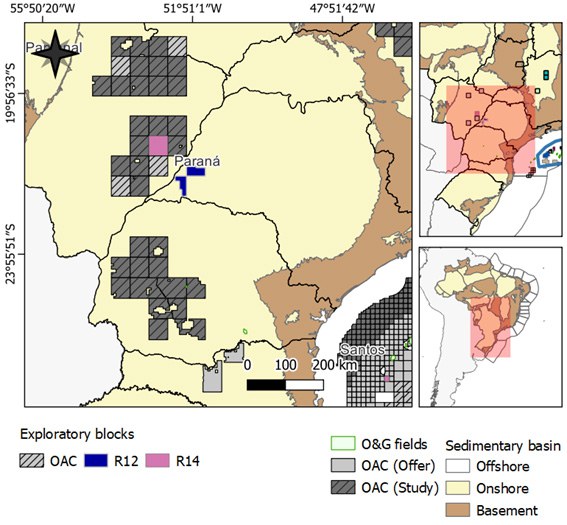
- Parecis Basin
Situated in the central-west region of Brazil, the Parecis Basin is an intracratonic basin located in the southeastern part of the Amazonian Craton. It spans approximately 350,000 km² of sedimentary area and is near regional centers such as Goiânia, Brasília, Cuiabá, and Campo Grande. The potential in this basin is primarily associated with natural gas discoveries.
For many years, the Parecis Basin was believed to be of Paleozoic origin. However, with the acquisition of new seismic data and the drilling of new wells, including those contracted by the ANP (2-ANP-4-MT and 2-ANP-6-MT), it’s now considered as a Neoproterozoic basin.
The basin also benefits from the availability of high-quality regional seismic datasets, which have been contracted by the ANP and are accessible to the public for download. These datasets provide valuable information and insights into the geological characteristics of the basin, aiding in exploration and resource assessment efforts. Researchers and industry professionals can freely access and download these datasets to further analyze the basin's geology and better understand its potential for hydrocarbon exploration and production.
There are 21 blocks available in the Open Acreage in this basin. Also, there is an additional stock of one block for future inclusion in the Open Acreage.

- Tucano Sul and Tucano Central Basin
The Tucano Sul and Central Basins, situated in the northeastern region of Bahia state, are characterized by an elongated N-S half-graben structure, with the eastern part exhibiting faulted borders. These basins are part of the larger Meso-Cenozoic Recôncavo-Tucano-Jatobá basin system. The Tucano Sul basin encompasses five fields that are currently producing natural gas.
In the first three cycles of the Open Acreage system, a total of seven blocks were acquired in the Tucano Sul basin. There are a total of 39 blocks available in the Open Acreage in these basins. Also, there is an additional stock of 15 blocks for future inclusion in the Open Acreage for the Tucano Sul basin.
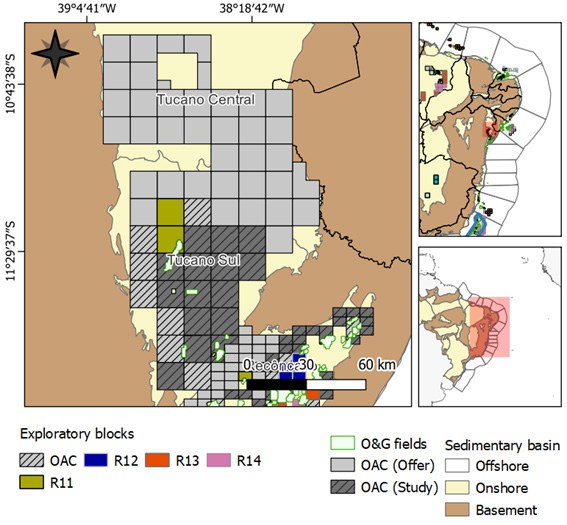
-
- Offshore Equatorial Margin Basins
-
The Brazilian Equatorial Margin comprises five sedimentary basins, with three of them having available blocks in the Open Acreage. This region is considered highly prospective for significant hydrocarbon discoveries in frontier areas. While some areas exhibit geological similarities to recent discoveries in Guyana, and Suriname, there are also local characteristics that make each basin unique. Notably, exploratory opportunities have been identified at various stratigraphic levels, potentially concentrated in reservoir clusters. These opportunities have been thoroughly evaluated using up-to-date seismic data, allowing for a comprehensive understanding of the petroleum systems.
Historically, exploration efforts in the offshore portion of the Brazilian Equatorial Margin have primarily focused on shallow waters. However, the latest geological model, based on new seismic data, suggests that the most promising opportunities lie in deep and ultra-deep waters. This highlights the vast untapped potential awaiting further exploration.
There are currently 81 blocks available through the Open Acreage system within the offshore equatorial margin basins and an additional stock of 213 blocks for future inclusion on the Open Acreage as summarized in the table below.
Basin
Blocks Available
Blocks in stock
Foz do Amazonas
47
157
Ceará
3
42
Offshore Potiguar
31
14
- Foz do Amazonas Basin
The 11th bidding round, which took place in 2013, marked the revival of bidding rounds in Brazil after a five-year hiatus. This event sparked the interest of major players in the Brazilian Equatorial Margin, particularly in the Foz do Amazonas Basin.
Subsequent internal studies conducted by ANP, as well as studies conducted by operators, confirmed the potential of the acquired blocks. However, to date, no wells have been drilled in these blocks due to the inability to obtain a drilling license.
These seismic and geological evaluations have revealed significant similarities between deep-water structures in the basin and the accumulations recently discovered in Guyana. The basin is characterized by the presence of sandstone turbidite reservoirs from the Cretaceous period, possibly charged by marine source rocks. This indicates the promising potential for hydrocarbon exploration and production in the basin.
There are 47 blocks available in the Open Acreage in this basin. Also, there is an additional stock of 157 blocks for future inclusion in the Open Acreage.
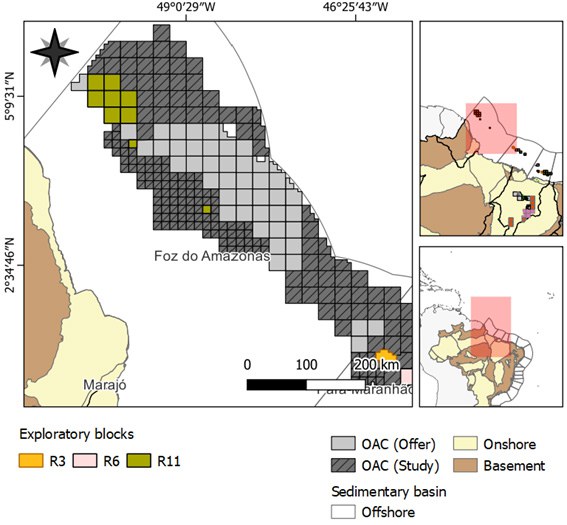
- Ceará Basin
The Ceará Basin originated from the separation of the paleocontinent Gondwana during the Early Cretaceous period. Its tectono-sedimentary evolution began in the Eo-Aptian stage, and its sedimentary fill can be divided into three main sequences: Rift, Post-Rift, and Drift.
In the Brazilian Equatorial Margin, both the Ceará basin and the offshore Potiguar basin, offer exploration opportunities in the Drift section, which includes sandstone turbidite reservoirs. However, the Rift and Post-Rift sections are considerably thick and represent significant exploration targets, especially in structural traps composed of carbonate and sandstone formations.
Currently, the Ceará Basin has four oil fields in production in shallow waters: Atum, Curimã, Espada, and Xaréu. These fields are important in confirming hydrocarbon generation in the marine portion of the basin. However, the focus of current exploration efforts has shifted towards deeper waters. Recent seismic data, both 2D and 3D, has identified compelling exploration opportunities across various stratigraphic intervals within the basin.
There are 3 blocks available in the Open Acreage in this basin. Also, there is an additional stock of 42 blocks for future inclusion in the Open Acreage.
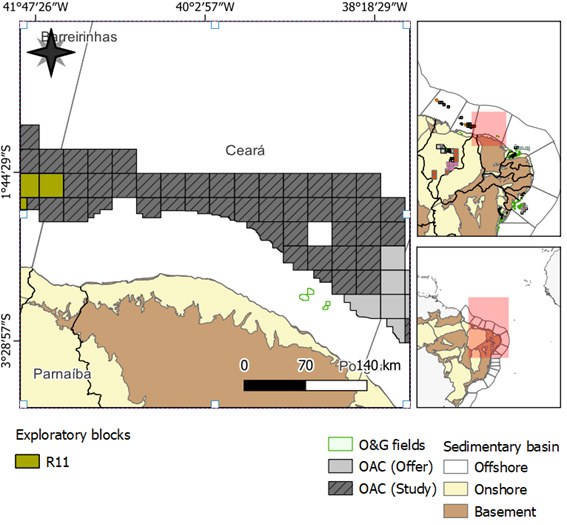
- Offshore Potiguar Basin
The offshore Potiguar Basin has four oil-producing fields: Agulha, Arabaiana, Cioba, and Ubarana, as well as two gas-producing fields: Oeste de Ubarana and Pescada.
In 2014, a significant discovery was made in the deep waters of the Potiguar Basin with the Pitu prospect (1-BRSA-1205-RNS). The well discovered oil in the Alagamar formation and gas in the Pescada formation, both in good quality reservoirs.
While the offshore Potiguar Basin is still considered a frontier basin, it has a long history of oil production in onshore and shallow water areas. In the deepwater region, there is potential for oil discoveries in Upper Cretaceous turbidite reservoirs, like the plays found in the West African Margin (such as Jubilee) and the Liza-Payara Complex in Guyana. The Pitu prospect confirmed the presence of structural traps in the Post-Rift section and the existence of source rocks in the oil window in deep waters.
There are 31 blocks available in the Open Acreage in this basin. Also, there is an additional stock of 14 blocks for future inclusion in the Open Acreage.
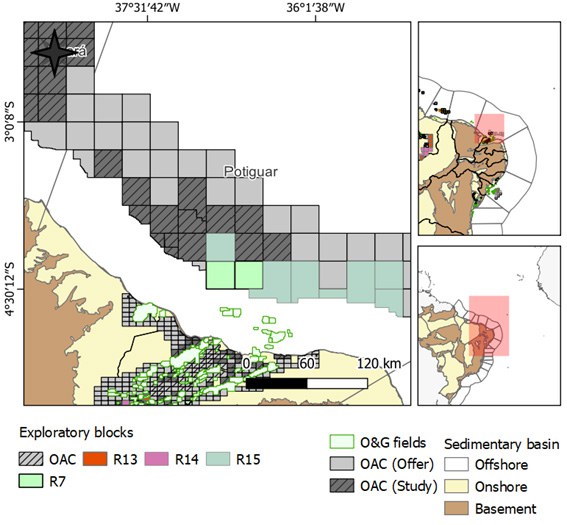
-
- Offshore Eastern Margin Basins
-
There are currently 480 blocks available through the Open Acreage system within the offshore eastern margin basins and an additional stock of 292 blocks for future inclusion on the Open Acreage as summarized in the table below.
Basin
Blocks Available
Blocks in stock
Camamu-Almada
12
0
Campos
17
29
Espírito Santo
20
0
Jacuípe
5
0
Pelotas
165
61
Pernambuco-Paraíba
9
0
Santos
252
202
- Pernambuco-Paraíba Basin
Pernambuco-Paraiba Basin, one of the least explored marine basins in Brazil, has yet to see any drilling activity despite its vast area of 212,901 km². It’s divided in two sub-basins: Pernambuco end Paraíba sub-basins. The Pernambuco Lineament acts as the internal division between the sub-basins.
The Marogogi High marks the southern boundary between the Pernambuco sub-basin and the Sergipe-Alagoas Basin, while the Touros platform serves as the northern limit of the basin.
Laboratory analysis of piston core ocean floor samples has revealed the presence of oil and gas in the collected sediments, indicating the existence of an active petroleum system. Although the available two-dimensional seismic data is limited, it suggests sufficient sedimentary thickness and the potential presence of reservoirs.
There are 9 blocks available in the Open Acreage in this basin.

- Jacuípe and Camamú Almada Basins
The petroleum system elements of the Sergipe-Alagoas Basin extend into the Jacuípe and Camamú-Almada basins, indicating a continuity of the Sergipe-Alagoas basin hydrocarbon potential towards these basins.
It is believed that hydrocarbon generation can occur from Albian-Cenomanian marine shales, like the Sergipe-Alagoas Basin. Deep-water wildcat wells are still required for the confirmation of this potential in deep waters.
In addition, there is a possibility of oil discoveries in the Upper Cretaceous and Paleogene turbiditic sandstones of the Urucutuca Formation. These reservoirs offer potential exploration opportunities in the Jacuípe and Camamu-Almada basins.
There are a total of 17 offshore blocks available in the Open Acreage in these basins.
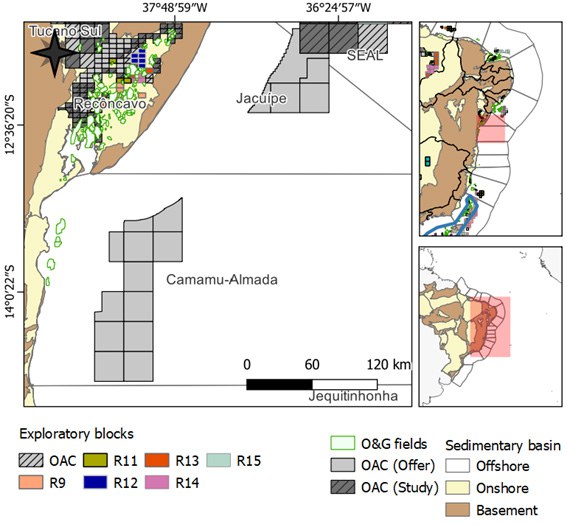
- Offshore Espírito-Santo Basin
The offshore Espirito Santo Basin has a long history of oil and natural gas production in both shallow and deep waters, particularly through the Golfinho oil and gas fields complex.
Currently, there are six prospects under evaluation in at offshore Espírito Santo basin, they belong to two prospect clusters, namely the Cachorros Cluster (Dogs Cluster) and Doces Cluster (Candies Cluster). These discoveries are characterized by late Cretaceous to Neogene sandstone turbidite reservoirs, which occur in structural, stratigraphic, and mixed traps.
There are 20 offshore blocks available in the Open Acreage in this basin.
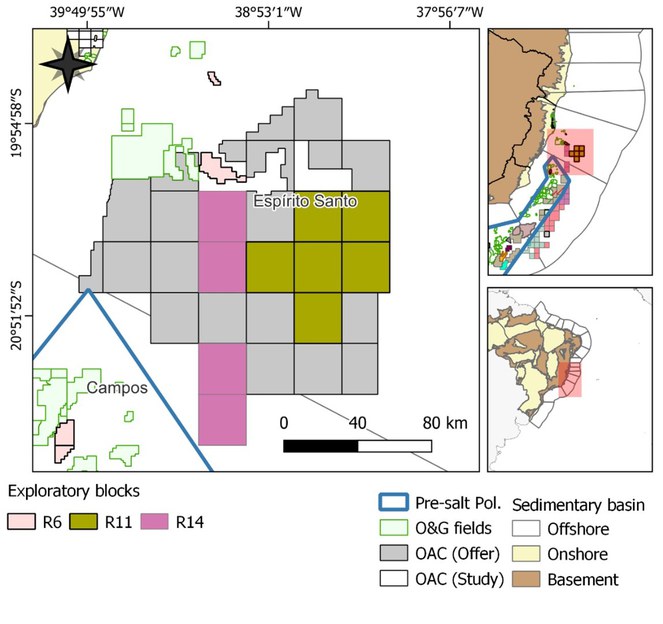
- Campos Basin
The Campos Basin, the second most productive in Brazil, is known for its oil and gas production from various reservoirs, including Post-salt sandstone turbidites and Albian carbonates, and the Pre-Salt play.
In shallow water there is potential for oil and gas discoveries in smaller turbiditic reservoirs, as well as significant potential for discoveries in the Albian carbonates, both within the Pos-salt play.
In the ultradeep, there is potential for discoveries in the Aptian carbonates within the Pre-salt play.
There are 17 blocks available in the Open Acreage under the Concession Regime. Also, there is an additional stock of 29 blocks for future inclusion in the Open Acreage.
Investment opportunities within the Pre-salt polygon are classified as Open Acreage under Production Sharing and are presented in a dedicated section in this webpage, providing detailed information on each area.
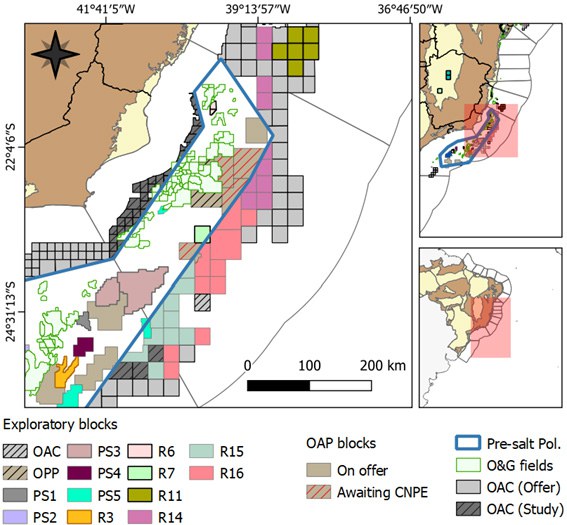
- Santos Basin
The Santos Basin, the most productive in Brazil, is known for its significant oil and gas production, primarily from the Pre-Salt play. Additionally, it has historical production from Post-salt sandstone turbidites and Albian carbonates.
There is potential for oil and gas discoveries in turbiditic reservoirs, as well as significant potential in the Albian carbonates, exemplified by the Caravela field. In this context, there is potential for medium-sized volume discoveries, like the Baúna field. These resources are part of the Post-salt play.
In contrast, the ultradeep water present a distinct exploratory context, focusing on Pre-salt carbonate targets.
There are 252 blocks available in the Open Acreage. Also, there is an additional stock of 202 blocks for future inclusion in the Open Acreage.
Investment opportunities within the Pre-salt polygon are classified as Open Acreage under Production Sharing and are presented in a dedicated section in this webpage, providing detailed information on each area.
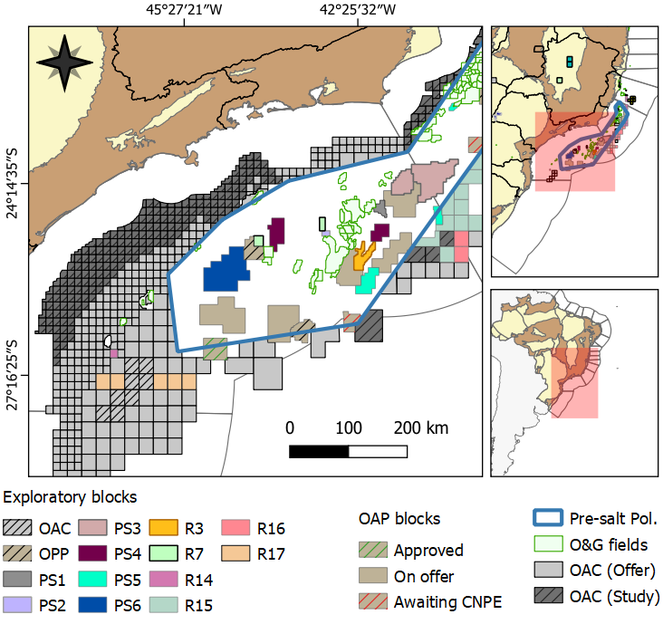
- Pelotas Basin
Situated in the southern frontier of Brazil, the Pelotas Basin is a new and promising frontier basin that still carries a high exploration risk. However, there are indications of an active petroleum system, including source rocks and hydrocarbon shows, as well as potential reservoirs identified in seismic lines.
The basin offers opportunities for discoveries in Upper Cretaceous turbidite sandstone reservoirs, primarily in stratigraphic traps in the southern region, and Albian carbonate reservoirs, predominantly in the northern region.
Seismic data analysis reveals the presence of Direct Indicators of Hydrocarbons (DHI), such as Flat Spots, Bright Spots, and Gas Chimneys, which sometimes occur together associated with potential hydrocarbon reservoirs.
Due to the relatively unstructured characteristics of the Pelotas Basin, it is of utmost importance to focus on the reservoirs located near the Cenomanian-Turonian marine source rock. Surprisingly, these exploratory targets remain mostly untested in the deep waters of the Pelotas Basin thus far.
There are 165 blocks available in the Open Acreage. Also, there is an additional stock of 61 blocks for future inclusion in the Open Acreage.
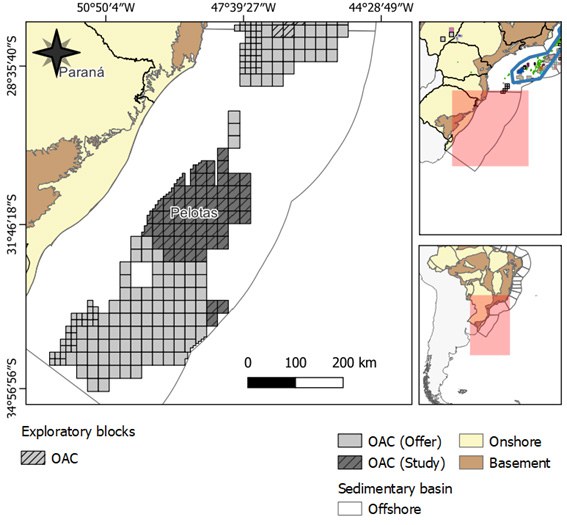
-
- Pre-Salt Polygon
Currently, there are a total of six blocks available in the Open Acreage under Production Sharing Regime (OAP), with one located in the Campos Basin and five in the Santos Basin. In addition to these, there is an additional inventory of six blocks that may be included in future cycles.
It is worth mentioning that among these blocks, the Ametista (Amethyst) block has already received authorization to participate in the OAP, as established by Resolution CNPE nº 4/2022 issued by the National Council of Energy Policy (CNPE). The other five blocks are awaiting a response from the CNPE. Below is a table summarizing the status of the blocks available in the AOP inventory.
Basin
Block
Status
Campos
Turmalina (Tourmaline)
Currently available in the Open Acreage
Citrino (Citrine)
Awaiting CNPE’s approval
Jaspe (Jasper)
Larimar
Ônix (Onyx)
Santos
Ametista (Amethyst)
Approved by Resolution CNPE nº 4/2022
Ágata (Agate)
Currently available in the Open Acreage
Cruzeiro do Sul (Southern Cross)
Esmeralda (Emerald)
Jade
Tupinambá
Mogno (Mahogany)
Awaiting CNPE’s approval
- Blocks on Campos Basin
-
The Turmalina (Tourmaline) block is currently available for bidding in the OAP in Campos Basin.
The National Agency of Petroleum, Natural Gas and Biofuels (ANP) has submitted the data, studies, and design of the Jaspe, Ônix, Citrino, and Larimar blocks to the Ministry of Mines and Energy (MME). These blocks await CNPE’s approval to be included in the Open Acreage under Production Sharing.
For all those blocks, the main exploration target is the Pre-salt of the Campos Basin.
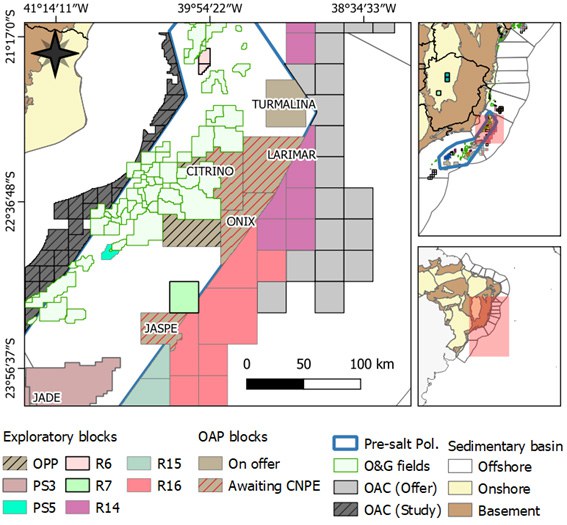
- Turmalina Block
The Turmalina (Tourmaline) Block is in the northeastern region of the Campos Basin, east of the Roncador and Albacora Leste fields, within a water depth range of approximately 2,000 to 2,500 meters.
Within this block, five prospects have been identified in the Pre-salt play, including a larger one named Turmalina and four upsides. All structures have four-way closure and are situated between a regional high to the west and a regional low to the east. The unrisked mean volume of oil initially in place (VOIP) for the Turmalina prospect was estimated at 2.26 billion barrels, and the sum of the unrisked mean VOIP for the upsides was estimated at 1.36 billion barrels.
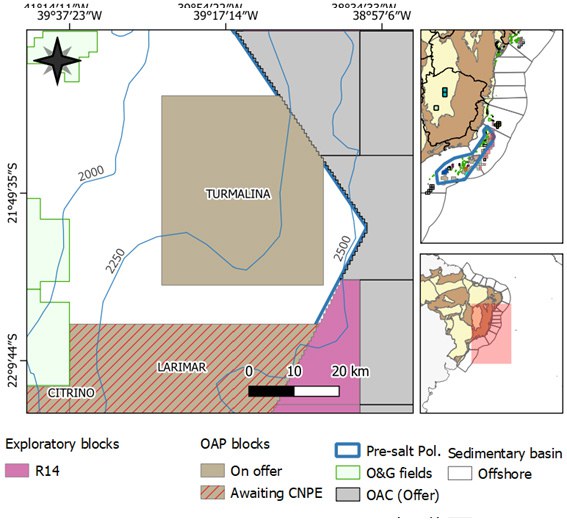
- Jaspe Block
The Jaspe Block features a main structure called Jaspe 1 in the Pre-salt, along with several upsides in the Coqueiros and Macabu formations within the same play. In this case, the primary fluid modeled for the structures was gas condensate. The estimated average unrisked hydrocarbon in place volume for Jaspe 1 is 875 million barrels of oil equivalent (BOE). The total estimated unrisked average volume for the block, considering the upsides, is 2.36 billion BOE.
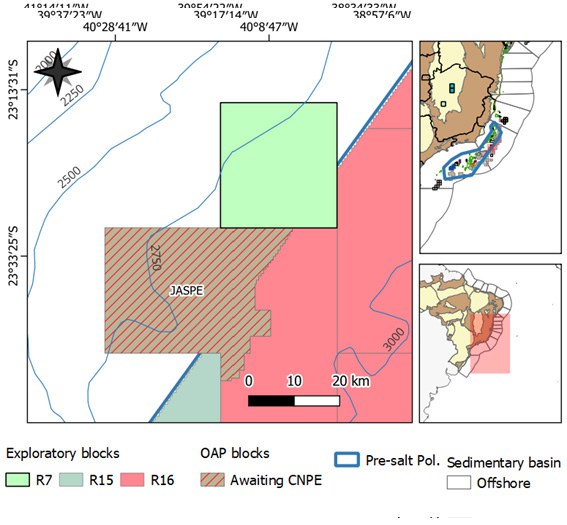
- Citrino, Ônix e Larimar Blocks
The Citrino (Citrine), Ônix (Onyx), and Larimar blocks are in the northeastern part of the Campos Basin, east of the Albacora, Marlim Leste, and Marlim Sul fields, in water depths ranging from approximately 1,000 to 2,750 meters. In the Citrino Block, oil has been considered as the main fluid. The block features a larger prospect in the Pre-salt and six upsides, with an estimated average unrisked volume of 3.56 billion barrels of oil in place.
For the Larimar and Ônix blocks, gas condensate has been modeled as the main fluid in place. Both blocks have a main prospect and several upsides in the Pre-salt. The estimated average unrisked volume of oil equivalent for the Larimar Block is 1.79 billion barrels. For the Ônix Block, the estimate is 1.46 billion barrels of oil equivalent. It is important to note that these blocks are awaiting approval from CNPE for inclusion in the Open Acreage.
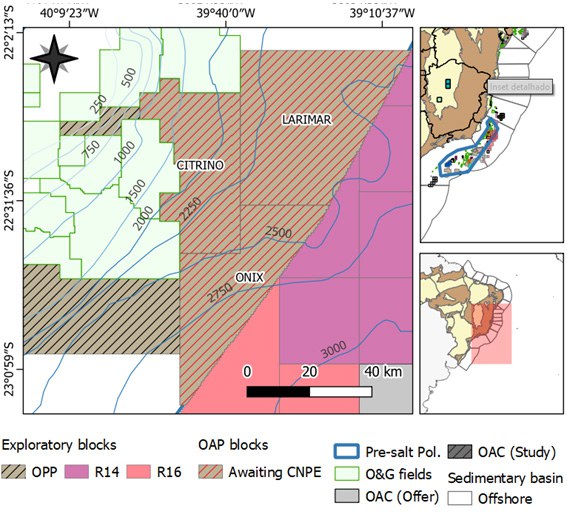
-
- Blocks at Santos Basin
-
The Jade, Ágata (Agathe), Cruzeiro do Sul (Southern Cross), Tupinambá, and Esmeralda (Emerald) blocks are currently being offered in the AOP, all with structures identified in the Pre-salt.
The Ametista (Amethyst) Block stands out from the others due to its main structure likely being composed of Albian carbonate reservoirs in the Post-salt. The inclusion of this block in the AOP has already been approved through CNPE Resolution No. 4/2022.
As for the Mogno (Mahogany) Block, it has distinct contractual characteristics compared to the others, as part of its structures are located beyond the limit of the Exclusive Economic Zone. This block is awaiting approval from CNPE to enter the Open Acreage.
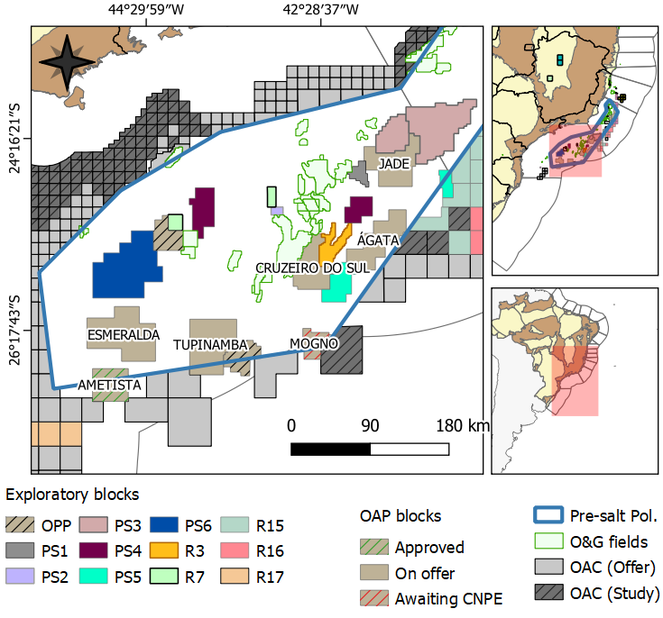
- Jade Block
The Jade block is in the Santos Basin, approximately 150 km offshore, with water depths ranging from 2,000 to 2,500 meters. The main exploration targets in the block are the Pre-salt carbonate reservoirs, located in structural highs with four-way closure, roughly aligned in the N-S direction. This configuration is associated with a system of rotated half-grabens, where the main faults predominantly dip to the east.
The block contains a primary prospect in the Pre-salt called Jade, with an estimated volume of 2.91 billion barrels of oil in place. Additionally, six upsides have been identified around this structure, two of medium size and the others of small size, all within the same play. The total estimated volume for the upsides is 4.2 billion barrels of oil in place.
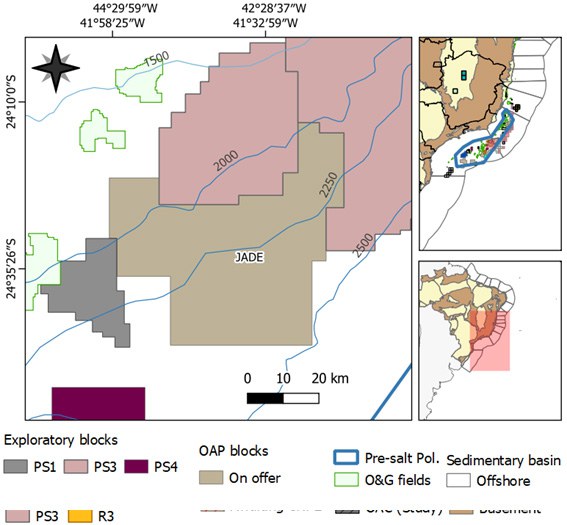
- Ágata Block
The Ágata (Agathe) Block is in the Santos Basin, at an average water depth of approximately 2,500 meters, about 250 km off the coast. In this block, a main prospect in the Pre-salt called Ágata has been identified, with an estimated unrisked average of 2.82 billion barrels of oil in place. Additionally, to the north of the main structure, there is an upside also in the Pre-salt with an estimated unrisked average of 370 million barrels of oil in place.
The main structure is situated on a structural high of the basement and is bounded by geological NE-SW faults, following the same structural trend as the Pau Brasil (Brazilwood) block.
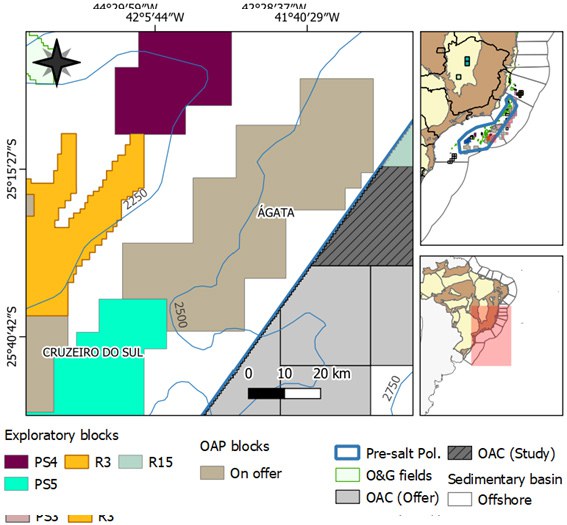
- Cruzeiro do Sul Block
The Cruzeiro do Sul (Southern Cross) Block is in the central region of the Santos Basin, at an average water depth of 2,200 meters. It is located east of the Tupi field, which is the largest oil-producing field in the country, and west of the BM-S-24 block, where the discovery of the Júpiter (Jupiter) accumulation in the Pre-salt was made.
Within the Cruzeiro do Sul Block, there is the extension of the Júpiter prospect, along with five additional upsides named Aurora, Gaia, Marte (Mars), Minerva, and Vênus (Venus), all belonging to the Pre-salt. The estimated average unrisked in place volume for Júpiter within the Cruzeiro do Sul Block is 1.17 billion barrels of condensate and 1.82 billion barrels of oil. The sum of the estimated average unrisked in place volume for the upsides is 3.0 billion barrels of oil.
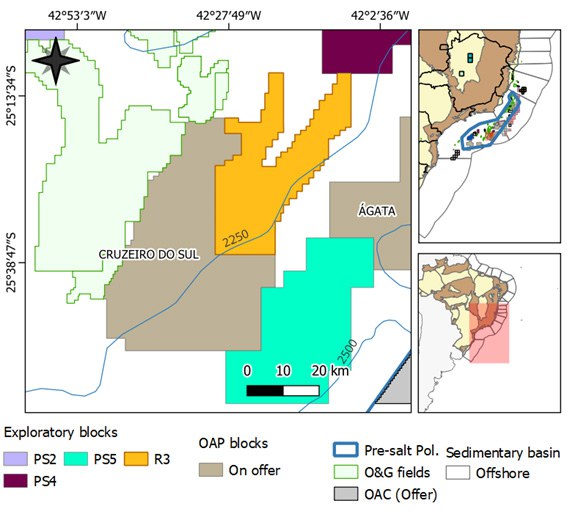
- Tupinambá Block
The Tupinambá Block is in the Santos Basin, between water depths of 2,250 and 2,500 meters, at an approximate distance of 300 km from the coast. The block is situated in the northwest portion of the Outer High of the basin. Within the block, there is a prospect in the Pre-salt play also called Tupinambá, with an estimated average unrisked original in-place volume of 4.2 billion barrels of oil.
This prospect exhibits four-way closure and is in one of the highest areas of the Outer High. The region has been significantly affected by successive tectonic events, resulting in deep and high-displacement normal faults. In the northern part of the block, exploratory wells have been drilled downdip in relation to this structure. Even under these unfavorable conditions, there are reports of oil shows in the wells.
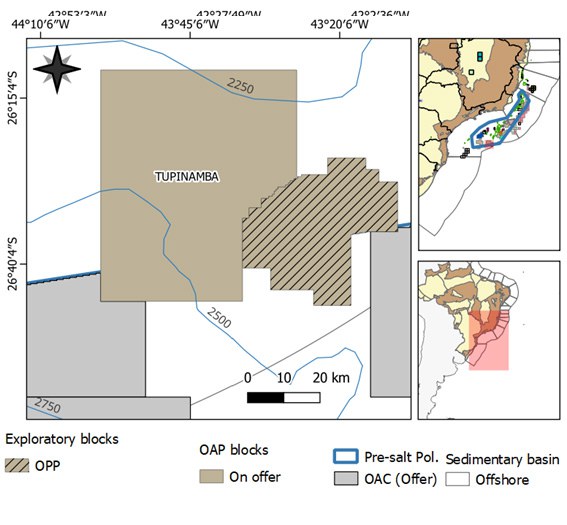
- Esmeralda and Ametista Blocks
The Esmeralda (Emerald) Block is in the Santos Basin, in water depths ranging from 2,000 to 2,500 meters, approximately 250 km off the coast. Within this block, two prospects have been identified in the Pre-salt play, named Esmeralda (Emerald) and Tupã.
The Esmeralda prospect exhibits well-defined four-way closure and is bounded by a major SW-NE-oriented normal fault dipping to the SE. The estimated average unrisked volume of oil in place (OOIP) for this prospect is 1.93 billion barrels.
The Tupã prospect is situated in one of the highest areas of the Outer High of the Santos Basin. It is a structural closure is conditioned by regional geological faults pinching out against the basement. The estimated average unrisked OOIP for this prospect is 3.95 billion barrels.
Despite the uncertainties in this area, well 1-BRSA-757B-SPS, drilled down-dip of the Esmeralda structure flank, revealed indications of good-quality oil in fine calcarenite reservoirs from the Albian section.
The Ametista (Amethyst) Block is in the southern part of the Santos Basin, near the Aram and Esmeralda (Emerald) blocks. It has an average water depth of 2,500 meters. The block has been fully imaged using recently acquired 3D seismic data by TGS in 2021. Its main structure, also called Ametista (Amethyst), is characterized by probable Albian carbonate reservoirs, in the Post-salt, over a volcanic high. The estimated average unrisked original in place volume (OOIP) for the Ametista prospect is 2.7 billion barrels.
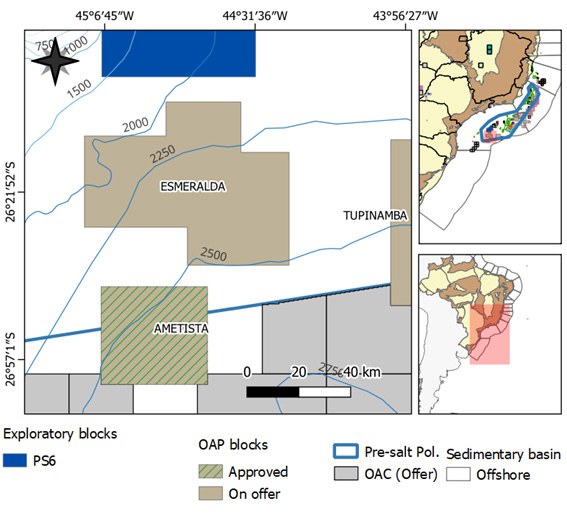
- Mogno Block
The Mogno (Mahogany) Block is in the Santos Basin, south of the Cruzeiro do Sul (Southern Cross) Block, at an average water depth of 2,500 meters. It features a larger Pre-salt structure also called Mogno and an upside. The main structure is estimated to have an unrisked mean volume of 4.14 billion barrels of oil in place. The upside, on the other hand, is estimated to have an unrisked mean volume of 1.05 billion barrels of oil in place.
One characteristic that sets this block apart from others is that a portion of the estimated volume extends beyond the Exclusive Economic Zone limit. Therefore, it is expected that payments need be made to the International Seabed Authority (ISA), calculated based on item 1 of Article 82 of the United Nations Convention on the Law of the Sea (UNCLOS). It's important to note that this block is awaiting approval from the National Council for Energy Policy (CNPE) to enter the Open Acreage.
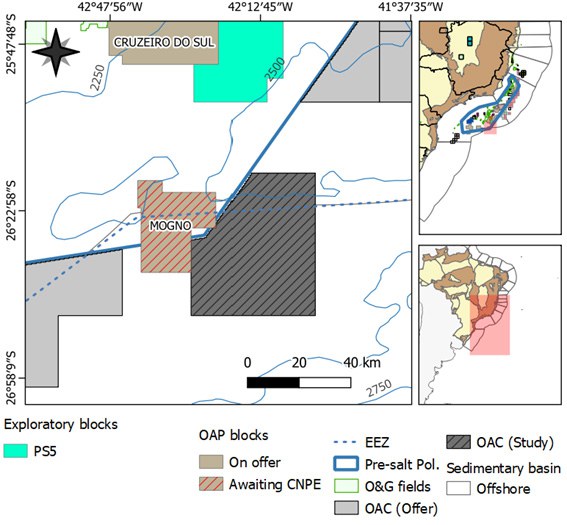
-
- Blocks on Campos Basin
- Onshore Potiguar, Sergipe-Alagoas (SEAL), Espírito Santo, Mucuri and Recôncavo basins
- E&P Strategic Goals and Measures
E&P Strategic Goals
Right assets in the right hands: the Petrobras Divestment Plan plays key role in this goal, because it enables, for example, the transfer of mature fields to small and medium-sized companies. ANP has also edited a series of measures to support small and medium-sized companies, as explained bellow.
Increase the recovery fator: Brazil’s Current RF is 10%, which represents an enormous opportunity in the mature fields.
Increase exploratory activities: the pandemic accelerated energy transition discussions and reinforced the sense of urgency in exploring our resources.
Make the marginal discoveries viable: there are many marginal discoveries in the different environments that could be developed if we address the correct incentives to make them viable. We need to keep increasing above ground competitiveness in order to achieve our main goals.
E&P and measures to stimulate the sector
Exploration and production form the basis of the oil industry. Great resources are invested in technological development, in the expansion of geological knowledge and in the formation of a chain of goods and services that support it. The exploration of the fields granted helps to expand the geological knowledge of the sedimentary basins.
A completely diverse sector will emerge from Petrobras Divestment Plan. All onshore and shallow water fields are being sold, as well as some great offshore post salt concessions.
With new investments in mature fields, pre-salt fields and offshore blocks in the exploratory phase, Brazil is ready to grow production and take a leading position in the sector.
An unprecedent transformation in the O&G sector and we continue to make progress in opening the sector. See below the measures already taken to encourage E&P activities.
Incentives for mature fields and small and medium-sized companies
- Royalties reduction: recently, in 2021, ANP approved royalties’ reduction for S&M companies. Before that, it was already approved the royalty reduction on the incremental production, which is the procedure to grant, at the request of the operating company, and proved the economic benefit, royalty reduction to up to 5% on the incremental production of mature fields.
- Mandatory investment or M&A in onshore and shallow water fields: in 2018, ANP set a deadline for Petrobras to divest in fields in which it had not been investing in recent years, in order to guarantee the continuity of the operation of these areas and achieve the maximum recovery factor possible. As a result, several fields have already been transferred to small and medium-sized companies.
- Marginal field definition, which was draft under public consultation. Specific incentives should be discussed afterwards.
Local content
- Changes in local content rules, which became simpler.
- Lower obligations and more flexible compliance with local content.
- Possibility for companies to make amendments in old contracts to change percentages of local content in accordance with the new rules.
- Option for companies to substitute the payment of fines for non-compliance with local content for new investments in goods and services in Brazil.
- Regulation of local content waivers, which establishes the criteria, requirements and procedures applicable to the exemption from compliance with the local content obligation.
Decommissioning
- Regulation of decommissioning guarantees, which establishes the procedures for the presentation of financial guarantees and term that ensure the financial resources for the decommissioning of production facilities in oil and natural gas fields.
- Regulation of decommissioning, which establishes rules and procedures for the decommissioning of oil and natural gas exploration and production facilities, the inclusion of land area under contract in a bidding process, the disposal and reversal of assets, compliance with remaining obligations, the return of the area and other measures.
Other measures
- RBL and M&A made easier: regulation of the process of assignment of contracts for the exploration and production of oil and natural gas, the constitution of guarantees on rights arising from these contracts, the change in the corporate control of concessionaires or contractors and other measures.
- Exploratory phase extension, which assures the signature of amendments to the concession contracts, so the companies have more time to make the necessary investments on exploration blocks.
- Repetro extension: Repetro is a special customs regime that allows the importation of specific equipment for oil and natural gas exploration and production activities, without the incidence of federal taxes and the Merchant Navy fee.
- Public digital technical data on onshore sedimentary basins and offshore well data are also available to companies, without cost (https://reate.cprm.gov.br/anp/).
- Natural Gas opportunities
- The new Gas Law, published in 2021, is a decisive step towards an open, liquid and competitive market. - A robust regulatory agenda is underway to build the new natural gas market, which is creating big opportunities in Brazil. - All efforts are being made so that the huge gas potential in the pre-salt can be monetized.
- Most of the onshore exploration in new frontier basins is to produce gas and there are relevant reservoir-to-wire projects in Parnaiba and Amazonas Basins.
- Downstream opportunities
- The Petrobras Divestment Plan also covers refining activities. The first refinery has already been sold by Petrobras (Landulpho Alves - RLAM) to the Mubadala Capital fund.
- Brazil is currently among the most attractive emerging markets for investments in renewable energy. It’s the 2nd largest producer and consumer of biofuels and 30% of the vehicle matrix is powered by renewable energies while 70% to 80% of our cars are flex-fuel. - RenovaBio program: In 2020, more than 14 million tons of greenhouse gas emissions were avoided thanks to the RenovaBio program, which aims to expand the production of biofuels in Brazil.
- Combustível do Futuro: another government program is Combustível do Futuro (Fuels of the Future), which encourages the large-scale use of 2nd generation ethanol; R&D to encourage fuel cell technology; creation of green corridors to supply heavy vehicles powered by biomethane; introduction of BioJetFuel; BioCCS etc.
